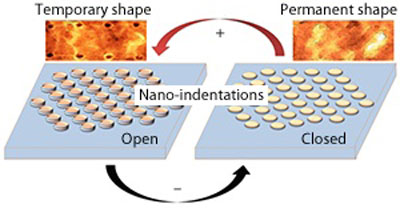| Jul 11, 2011 |
Polymer actuators with shape memory for cell biology and photovoltaics
|
|
(Nanowerk News) Molecular switches transform between one shape and another in response to a stimulus such as heat or electric current. Indicators of pH are some of the earliest molecular switches. Now the race is on to create new molecular switches for use in nanocomputers and other nano-scale applications.
|
|
Thermo-softening plastics are polymers that change shape with the application of heat, and they can be used as heat-actuated switches in many applications. Heating and cooling, however, are not feasible at the tiny scales of nanocomputers, meaning that scientists need to find another approach. Michael Higgins and co-workers at the University of Wollongong in Australia have now made polymers that change reversibly between one form and another on the nanoscale in response to an electrical current ("Reversible Shape Memory of Nanoscale Deformations in Inherently Conducting Polymers without Reprogrammin").
|
 |
| Ions move into the polymer under reducing conditions, filling the nanoindentations.
|
|
The team was originally experimenting with the reprogramming step in atomic force microscopy (AFM). Reprogramming refers to the process of 'pricking' a flat sheet of polymer with an AFM tip to form a series of nano-sized reference points for use in imaging. Heating the dimpled surface returns it to its original smooth form. Subsequent cooling, however, does not bring back the dimpled surface. "We wanted to see if we could eliminate the reprogramming step by using nanoscale actuation and the idea of polymers having a memory," says Higgins.
|
|
In their experiments, the researchers examined the memory behavior of the polymer polybithiophene. They found that after creating indentations a few nanometers deep across the polybithiophene surface, the application of a reducing current caused it to smooth out again as anions and solvent molecules flooded into the polymer, plumping up the surface (see image). Reversing the current caused the anions and solvent to leave the surface, restoring the temporary, dimpled surface. In polybithiophene, this process does not exert enough energy to disrupt the tangle of polymer molecules, and so the original shape is remembered, in contrast to other polymers, which require reprogramming.
|
|
The novel nano-actuation of polybithiophene using electric current paves the way for applications in cell biology, organic solar cells and electrochemical devices, in which the change in color or shape in response to a burst of current could provide sensing functionality.
|

